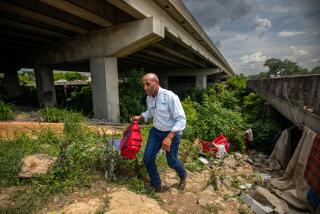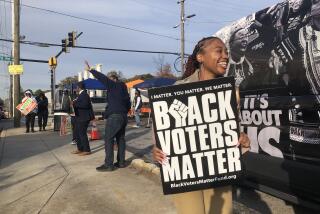In Waycross, the Candidates Are Dimly Seen
- Share via
WAYCROSS, GA. — Driving away from Savannah and into the swampy heart of southeast Georgia, Old South charm fades to decomposing autos forming bunkers in front of nearly every house along U.S. 82. An automobile driver battles for lane rights against semis stacked with pine logs roaring toward the pulp mill. The AM car radio options are country-and-western gospel (“Walkin’ On With Jesus”) or traditional gospel.
The two-lane roadbed across the flat Georgia lowland is a levee separating swamp and pine forest on one side from swamp and pine forest on the other.
A hundred miles from Savannah, beyond the First Free Will Baptist Church and a National Guard armory marquee advertising Ladies and Midget wrestling, U.S. 82 threads a strip of fast-food stands and convenience stores into Waycross, Pop. 20,000, proclaimed locally as “the Largest City in the Largest County in the Largest State east of the Mississippi.”
Waycross, Ware County, Ga., is part of the playing field in the South’s Super Tuesday presidential primary, but Waycross voters have been distant observers. The candidates have campaigned from one New South city to the next, from Charlotte, N.C., to Nashville, Tenn., to Atlanta, but not to Waycross. Waycross voters were not necessarily uninterested in the contest, but in the weeks before the primary, they had more immediate concerns--an election for mayor, racial incidents in the local schools and a campaign to attract jobs.
The South is no longer a political monolith. It is also not as monolithic culturally as outsiders assume. In many aspects, the problems of Waycross may be closer to those of Rock Springs, Wyo., than Atlanta.
Candidates may bypass Waycross, but Waycross is used to being bypassed, first by the interstate highways that siphoned off Florida-bound tourist traffic, and then by the New South economic miracle that brought shiny office towers and research parks to the cities. Even the modern technology that has touched Waycross has been a mixed blessing. Waycross, founded as a railroad town in 1875 where the Savannah, Florida and Western Railroad intersected with the Brunswick and Florida Railroad, has one of the east’s largest rail switching yards. But with deregulation and computerization, employment has declined to about a third of its one-time peak of 3,000.
So Waycross remains an isolated, economically depressed trade center where population and retail sales have remained flat for 20 years. The median household income is half the national level. The population is aging and residents despair that the best young people go off to school and never return.
Waycross’ sin is being rural in an age of urbanization. When Chamber of Commerce Manager Saralyn Stafford talks of southeast Georgia to outsiders, she draws empty looks. “They all know about Atlanta. They think Georgia ends when you get to Macon,” Stafford said.
A woman in charge--particularly one under 30--is something new. Stafford, weary of hearing “we’ve never done that before,” is out to get a stagnant Waycross moving.
In the past, businesses lived off the railroads and little was done to attract new industry. There was no coordinated leadership. No one knocked on doors of the state economic development people in Atlanta and demanded attention.
“We are building relationships now--from ground zero,” Stafford said. “We haven’t always had that. We’ve had a good ol’ boy network.”
Waycross is beginning to get attention, but pulling the community together is not easy. Businesses have moved from downtown to the Hatcher Point shopping center out U.S. 1 on the way to Okefenokee Swamp Park. City center brick buildings are dingy. Shoppers complain about traffic, complicated by the railroad grade crossings in the middle of town, about poor service and the lack of a downtown department store and good restaurants.
Complicating the political fabric is an ethnic gulf between Waycross and surrounding Ware County. Blacks account for about half the city population but only a fraction of the rural. Most counties in the region have one high school but Waycross and Ware County maintain separate schools, with occasional racial tension between them. Stafford has begun a political education campaign among businesses and school consolidation is high on the agenda. But one old-timer chuckled at talk of consolidation and drawled, “Oh, that subject comes up every once in a while.”
All in all, Waycross is not an ugly or unpleasant town, unless a visitor comes with unrealistic expectations about the elegant charm of the antebellum South or the extent of the economic vitality of the New South. The older downtown buildings may be dingy, but are still solid and could be refurbished at modest expense. The center of town is anchored by government offices and a federal courthouse. If additional business leaves, however, the downtown may become moribund and the outskirts even more tacky and cluttered.
Waycross has pleasant residential areas with tree-lined streets and handsome homes with spacious lawns. A modern three-bedroom house can be had for $50,000. There is a community college, a vocational-technical school and several small industries. The Okefenokee Swamp is an unexploited attraction of great potential. Deer hunting and bass fishing are excellent. While many want to see Waycross boom, others like it as it is.
Of racial troubles, one young black professional said, “It’s no better or worse than any of the other counties around.” And a respondent to a consumer survey said, “I don’t know of any improvements needed. I came here in 1909 and I could write a book about Waycross. It’s the best place in the world to live.”
Waycross probably is not on the threshold of economic boom--or bust. But new energy and leadership and a modest investment of funds could make downtown Waycross an attractive place to work, shop, entertain and enjoy cultural events. Stafford does not have excessive expectations. “We just want our people to stay here,” she said. “We have good lives.”
That, in fact, is the modest goal to which hundreds of bypassed American communities aspire.
More to Read
Get the L.A. Times Politics newsletter
Deeply reported insights into legislation, politics and policy from Sacramento, Washington and beyond. In your inbox twice per week.
You may occasionally receive promotional content from the Los Angeles Times.










